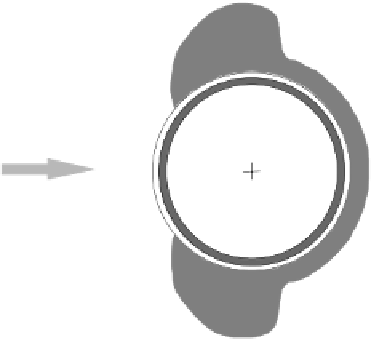Environmental Engineering Reference
In-Depth Information
collector and to the height of the chimney. For instance, in case of a large solar
updraft tower power plant ambient air temperature is typically increased by 35 K,
so that an air flow speed of approximately 15 m/s is created inside the chimney.
Technically speaking, the chimneys of solar updraft tower power plants are very
big atmospheric cooling towers.
Towers of a height of 1,000 m represent a great challenge, which is well con-
trolled nowadays. For instance, the high-rise building Burj Dubai, currently under
construction, is to be over 700 m high, and for Shanghai a high-rise building of
over 800 m is being planned. For a solar updraft tower power plant only a simple
hollow cylinder is required. This cylinder does not have a very slim shape and the
requirements are considerably lower compared to residential buildings.
Such towers can be built using different technologies; besides free-standing re-
inforced concrete tubes
also steel towers or guyed tower tube designs with sheet
or membrane cladding are possible. Studies have shown that virtually for all con-
sidered sites reinforced concrete represents the most durable and cost-effective
alternative.
For such a tower of a height of 1,000 m the wall thickness is slightly above 1 m
at the bottom. This thickness would decrease to approximately 0.3 m at half of the
height and remain constant afterwards. Yet, such thin tunnels are deformed by the
wind load to an oval cross-section ("ovalisation"). This is particularly true for the
suction flanks, represented in Fig. 5.29. Meridional stress becomes very high, so
that stiffness is reduced because of cracking and there is also the danger of buck-
ling. Ovalisation can effectively be avoided by bundles of strands in the form of
lying spoke wheels stretched across the tower cross-section. They have the same
stiffening effect as diaphragms, but reduce the updraft only minimally.
c
p
c
p
= - 0.45
= - 0.45
c
p
c
p
= + 1.00
= + 1.00
Wind direction
Wind direction
Pressure
Suction
Pressure
Suction
c
p
c
p
= - 1.50
= - 1.50
Fig. 5.29
Typical distribution of pressure/suction for the flow around a circular cylinder
(
c
p
coefficient of pressure)
Turbines.
Energy is extracted from the air flow by means of turbines. Such tur-
bines to be used for solar updraft tower power plants are not velocity-staged, as







































Search WWH ::

Custom Search